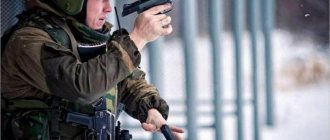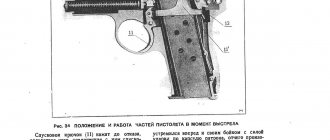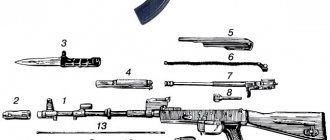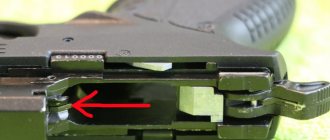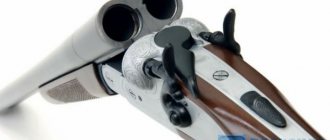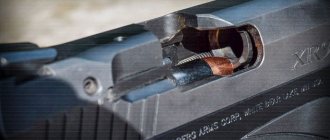Many people who purchase an air pistol do not even think about the fact that it requires care: timely cleaning and lubrication of the weapon can significantly extend its service life. Caring for your gun is essential, even if the model you purchased is simple and is used solely for recreational shooting. However, such a basic procedure as cleaning and lubricating pneumatics seems very difficult to many pistol owners - which is why they try to avoid it. In this article we will prove that keeping track of weapons is easy and does not require excessive financial or time expenditure.
Air gun care: basic rules
The first thing to remember is that care must be regular. It is necessary to clean and lubricate weapons at regular intervals, and not once a year when you suddenly remember about it: such care will be of little use. When caring for pneumatics, follow these simple rules:
- After shooting, perform partial disassembly, if the design allows, clean the barrel from traces of oil and dust and lubricate it with gun oil specially designed for this purpose. If you neglect this point, then over time the remains of the oil in the barrel that burned during the shot will turn into a metallic coating on the walls of the barrel. This process in the weapons industry is called “galvanizing” or “copper plating,” depending on the material of the projectile. In spring-piston models, this is “leaded”, since lead bullets are used for shooting.
- Don't overdo it when cleaning - be gentle. Too rough and sharp movements with a brush can leave small scratches on the barrel. Do not pour too much oil, as its residue may linger in the barrel, which will inevitably lead to damage to the gun.
- Do not neglect the rules for storing an air pistol. If you store a weapon in a damp environment and in the wrong position, the parts will quickly rust and the product will fail sooner than it otherwise would. We will talk about storing air guns later in the article.
Cheat sheets for exams and tests
| See also... |
| Cheat sheets for the exam in the discipline of fire training |
| Use of firearms |
| Purpose, design and principle of operation of the UZRGM fuse |
| History of the creation and development of hand fragmentation grenades |
| Initial bullet speed and its practical significance |
| Phenomena occurring when fired from a small weapon |
| The influence of shooting conditions on bullet flight |
| Reasons for bullet scattering |
| The procedure for incomplete disassembly of the PM |
| Purpose and design of the striker, ejector and fuse (PM) |
| Purpose and device of the shutter |
| Procedure for inspection, cleaning and lubrication of PM |
| Purpose and device of the pistol accessory |
| The operation of pistol parts and mechanisms to expend cartridges from the magazine |
| Operation of parts and mechanisms of a loaded pistol when the safety is turned on |
| Checking the pistol's combat and bringing it to normal combat |
| Conditions and procedure for performing exercises from PM |
| Delays when firing from an MCM pistol and ways to eliminate them |
| Design and purpose of TOZ-36 and TOZ-49 revolvers |
| Design of a 5.6 mm small-caliber cartridge |
| Purpose, design and technical characteristics of the TOZ-18 carbine |
| Purpose and combat properties and design of the RGD-5 grenade |
| Handling pomegranates, care and conservation |
| Purpose and combat properties of the AK-74 assault rifle |
| Delays when firing the AK-74 and how to eliminate them. |
| Operation of parts and mechanisms of the AK-74 assault rifle |
| Design of 5.45 mm and 7.62 mm (model 1943) cartridges |
| All Pages |
Page 12 of 27
Procedure for inspection, cleaning and lubrication of PM.
To determine the condition of the weapon, its serviceability and combat readiness, periodic inspections of the pistols are carried out within the prescribed time limits. The pistol is inspected either assembled or disassembled. The degree of disassembly is determined before each inspection. Simultaneously with the inspection of the pistol, the holster, spare magazine, wiper and pistol strap are inspected. Every police officer armed with a pistol must inspect the pistol daily, before going to class, before shooting, and during cleaning. Before going to class and immediately before shooting, inspect the pistol in assembled form, and during cleaning - in disassembled and assembled form.
The pistol must be kept clean and in good working order at all times. This is achieved by timely and proper cleaning and lubrication, careful handling of the gun and proper storage of it.
Cleaning of pistols is carried out: in a combat situation, during maneuvers and long exercises in the field daily during a lull in the battle or in breaks between classes; after exercises, orders and training in the field without shooting, immediately after the end of the exercises, orders or classes; after shooting, immediately after shooting, it is necessary to clean and lubricate the barrel bore and chamber; Perform final cleaning of the pistol upon returning from shooting; in the next 3 - 4
Clean the gun daily; if the gun is not in use - at least once every 7 days. Apply lubricant only to a well-cleaned and dry metal surface immediately after cleaning to prevent moisture from affecting the metal.
To clean and lubricate the gun, use: liquid gun lubricant (from +5 to -50°C); gun lubricant (from +5°C and above); RFC solution (barrel cleaning solution) for cleaning channels, barrels and other parts of the pistol exposed to powder gases; rags or paper KB-22; tow (short flax fiber). Cleaning the pistol with an RFS solution is carried out only after shooting at the shooting range or in the barracks. In field conditions, the pistol can be cleaned only with liquid gun lubricant.
Clean the gun in the following order: Prepare cleaning materials and lubricants. Inspect the accessory. Disassemble the gun. Clean the bore. Clean the pistol frame with barrel and trigger guard. Clean the bolt, return spring, bolt stop and parts of the firing mechanism. Wipe the handle. Clean out the store. Wipe down the holster. Wipe the wipe dry.
Lubricate the gun in the following order: Lubricate the barrel bore. Lubricate other metal parts and mechanisms of the gun. Do not lubricate the holster, but only wipe it dry with a rag and dry it. Lubricate the wipe.
Once lubrication is complete, reassemble the gun. A gun brought from a frost into a warm room must not be lubricated. A pistol handed over for long-term storage must be thoroughly cleaned, the bore and trigger mechanism lubricated with liquid gun lubricant, wrapped in one sheet (layer) of inhibited paper and two sheets (layers) of waxed paper and sealed in a cardboard box. Lubricate the parts and mechanisms of the gun at an outside temperature of +5°C and below only with liquid gun lubricant.
Purpose and structure of the PM store
The magazine holds eight rounds. It consists of a body, a feeder, a feeder spring and a cover. 1 — store body; 2 — feeder; 3 — feeder spring; 4 — magazine cover. The magazine body connects all parts of the magazine. 1 - window; 2 - curved rib; 3 - protrusion; 4 - cutout; 5 - gutter. The upper edges of the side walls of the case are bent inward to hold the cartridges and feeder, as well as cartridges when they are fed into the chamber by the bolt. It has: windows in the side walls to reduce the weight of the magazine and to determine the number of cartridges in the magazine; at the bottom there are curved ribs for the magazine cover, a cutout for free passage of the left wall of the magazine cover, a groove for the passage of the feeder tooth. The magazine is inserted into the base of the handle through the lower window.
The feeder is used to supply cartridges. 1 — bent ends; 2 - tooth. It has two bent ends that direct its movement in the magazine body. On one of the bent ends of the feeder on the left side there is a tooth for turning on the bolt stop when all the cartridges from the magazine are used up.
The feeder spring serves to feed the feeder with cartridges upward when firing. The lower end of the spring is bent to lock the magazine cover. The magazine cover has a hole for the bent (lower) end of the feed spring and grooves with which it fits onto the curved ribs of the magazine body.
/ - hole; 2 - grooves.
Pneumatic care products
Choosing quality cleaning accessories should be given as much attention as purchasing the gun itself. You can purchase ready-made kits that include a cleaning rod, a brush and a powder puff. A cleaning rod is used to lubricate the barrel with oil, a brush can be used to remove any remaining burnt oil, and a powder puff can be used to dry the gun barrel after you have washed it.
Pistol cleaning kit, caliber 4.5 mm
Buy a pistol cleaning kit, caliber 4.5 mm
Timely care of the weapon will significantly extend its service life and help avoid breakdowns and other related problems. Additionally, each type of gun needs to be cleaned differently using different tools. This set is designed for cleaning pistols with a caliber of 4.5 mm and includes a metal cleaning rod of 2 parts, 3 brushes, a visher, and napkins (100 pcs./pack).
Pneumatic cleaning kit in a bag, caliber 4.5 mm
Buy a pneumatic cleaning kit in a bag, caliber 4.5 mm
Cleaning kit for air guns. The set includes a 2-arm brass cleaning rod 4 mm, a metal bristle brush, a cotton brush - everything you need for high-quality care of the product. All items are packed in a sealed plastic bag.
However, just because you bought a kit doesn't mean you won't need additional cleaning tools. The cleaning rod comes in one standard size and may not fit your pistol model. The puff requires replacement regularly: after about 20 uses, it loses its ability to absorb moisture. And the brush wears out over time - it’s always better to have a few in stock.
Set of brushes (in blister) caliber 4.5 mm
Buy a set of brushes (in blister) caliber 4.5 mm
Timely maintenance of the weapon ensures its stable and safe use. Therefore, the owner of a weapon should get a cleaning kit in time. If you already have a cleaning rod of the appropriate size, you can purchase this set of brushes. They can serve as a replacement for a set of 4.5 caliber brushes. They can also be added to your collection of care accessories and used for guns of the appropriate caliber. The set includes two spiral brushes and one cotton visher - puff.
ShotTime cleaning kit, caliber 4.5 mm, for air guns (3 brushes)
Buy ShotTime cleaning kit, caliber 4.5 mm, for air guns (3 brushes)
It's no secret that with proper care, air guns will last you much longer. To keep your rifle or pistol neat and clean, all you need to do is purchase a ShotTime cleaning kit. It is designed for all types of air guns with a caliber of 4.5 mm. To dry shotguns, you may also need items such as rags, felt patches or tow.
Cleaning weapons correctly
After you have purchased all the necessary tools, you can begin cleaning the weapon. As we have already said, it is necessary to clean the gun after each use. For this:
- We perform partial disassembly of the product - if you have not done this before, you can read the instructions for the gun or watch a video on Youtube;
- We clean the barrel using a product specially designed for this purpose. Do not overdo it: the cleaning product is usually based on kerosene, the residue of which is difficult to remove.
Gun oil Ballistol spray, 100 ml
Buy gun oil Ballistol spray, 100 ml
This composition is intended for cleaning firearms, gas and pneumatic weapons. With its help, the barrel bore, parts of the gas reloading system and the gas exhaust mechanism are cleaned of powder deposits and lead. Ballistol is a universal oil that protects metal and wood products. Capable of removing hardening, deposits of lead, copper and tombac from barrels, chambers and other metal parts of weapons, including firearms. The oil will also protect the wood parts. It can be used to clean, soften and impregnate holsters, shoulder straps, and belts.
Composition for removing carbon deposits and lead Huntex premium, 100ml
Buy composition for removing carbon deposits and lead coating Huntex premium, 100ml
This composition is designed to neutralize and remove combustion products and lead coating of the barrel bore, gas release mechanism and parts of the reloading system of all types of firearms. Has good dissolving ability. Contains active alkaline components. The composition effectively cleans surfaces from contamination, having a gentle effect on the metal. Huntex premium contains no mechanical impurities or inorganic alkalizing agents.
- After treating the barrel with a cleaning agent, go over it with a brush. Choose a plastic or metal model, depending on the degree of contamination of your gun.
- The barrel can then be rinsed in soapy water. Dishwashing detergents are also suitable for this purpose: with their help it is easier to remove kerosene and shavings that inevitably form during the cleaning process. You can use a cleaning rod - it will definitely remove dirt.
- Finally, we dry the barrel naturally in a warm room or near a heating radiator. Remaining water is removed using a powder puff or rag.
After cleaning, be sure to lubricate the barrel with gun oil. We’ll look at how to do this correctly in the next paragraph.
Cleaning and lubricating the gun
The pistol must be kept clean and in good working order at all times. This is achieved by timely and proper cleaning and lubrication, careful handling of the gun and proper storage of it.
Pistols are cleaned:
— in the field — daily;
- after shooting - immediately after shooting, it is necessary to clean and lubricate the barrel bore and chamber, the final cleaning of the pistol must be done upon returning from shooting; in the next 3-4 days, clean the gun daily;
- if the gun is not in use - at least once every 7 days.
Apply lubricant only to a well-cleaned and dry metal surface immediately after cleaning to prevent the metal from being exposed to moisture.
Cleaning of pistols is carried out in specially designated areas on tables equipped or adapted for this purpose, and in a camp environment - on mats, boards, plywood, etc., previously cleaned of dirt and dust.
To clean and lubricate the gun, use:
— liquid gun lubricant — for cleaning the pistol and lubricating its parts and mechanisms at air temperatures from +5 to -50 degrees Celsius;
- gun lubricant - for lubricating the barrel bore, parts and mechanisms of the gun after cleaning them; this lubricant is used at air temperatures of +5 degrees and above;
- rags (cotton fabric) - for wiping, cleaning and lubricating the gun;
- tow (flax fiber), cleared of kernels, - only for cleaning the bore.
To make it easier to clean grooves, cutouts and holes, you can use wooden sticks, brushes and brushes.
In field conditions, the pistol can be cleaned only with liquid gun lubricant.
You can also use modern products to clean the gun. These include solutions and aerosols for removing powder deposits and copper plating (WD - 40, etc.).
Two types of products are used to lubricate the gun. First view
- actually for lubrication - aerosols that form a thin film on the metal, which prevents moisture from penetrating the metal, and also reduces friction between the metal, allowing the contacting surfaces to slide freely.
The second type
of means is used for preservation
-
aerosols and lubricants that form a fairly thick layer of lubricant (about 1 mm). The lubricant envelops the surface and does not flow off it.
Clean the gun in the following order:
1) Prepare cleaning materials and lubricants.
2) Disassemble the gun.
3) Clean the bore.
4) Clean the pistol frame with barrel and trigger guard.
5) Clean the bolt, return spring, bolt stop and trigger parts.
6) Wipe the handle.
7) Clean out the store.
 Wipe down the holster.
Wipe down the holster.
9) Wipe the wipe dry.
Lubricate the gun in the following order::
— lubricate the bore;
— lubricate the remaining metal parts of the gun mechanisms;
- lubricate the wipe;
— after lubrication is complete, reassemble the gun.
A gun brought from a frost into a warm room cannot be lubricated until it “sweats”; when drops of water appear, without waiting for the moisture to dry, wipe the parts and mechanisms of the gun dry and lubricate them.
A gun handed over for long-term storage must be thoroughly cleaned and lubricated with a preservative lubricant, wrapped in one sheet (layers) of inhibited paper and two sheets (layers) of waxed paper and sealed in a cardboard box.
Parts and mechanisms of the pistol should be lubricated at an outside temperature of +5 degrees Celsius and below only with liquid gun lubricant or WD - 40.
21. Standards for fire training Standards for fire training are developed in order to consolidate and test employees’ knowledge of the material part of the weapon, measures safety, shooting techniques and skillful use of weapons. When conducting fire training classes, it is necessary to practice fire training standards on a monthly basis. During classes, employees work out fire training standards, initially at a slow pace, then temporarily. An individual assessment for fulfilling standards for fire training is entered in the journal of class attendance and progress in professional service and physical training. The standard for fire training is considered fulfilled if the conditions for its implementation are met and there are no violations of the requirements of the shooting course. If an employee makes a mistake while working out the fire training standard, which could lead to injury or damage to the weapon, fulfillment of the standard is stopped and an “unsatisfactory” rating is given. The time for fulfilling the fire training standard is counted from the command “Proceed to meet the standard” to the report “Standard fulfilled” , which is carried out by the employee after he has completed the last action of the standard.
Weapon Lubrication
If the barrel is not lubricated regularly, it will promote rapid galvanization. Therefore, after each cleaning, lubricate the weapon, following this algorithm:
- We select a cleaning rod to match the size of the barrel and lubricate it with gun oil. The best option is a bottle with a spray bottle; it will allow you to apply the oil evenly and not overdo it with the amount. Choose a product with silicone: it lubricates mechanisms that are usually difficult to reach.
- We lower the cleaning rod into the barrel and lubricate the weapon. The part must be kept in a vertical position, and also make sure that there is not too much oil on the cleaning rod - it should not drain.
- After lubricating the barrel, pay attention to other parts of the gun. To lubricate them, you can use a soft thin brush.
After the product is oiled, check to see if you have used too much oil. To do this, take a couple of test shots - if a large amount of smoke is released, this is a sure sign that you have gone too far. Some of the oil must be removed using a powder puff or rag. If you do not do this, over time, plaque will form in the barrel of the weapon.
How to lubricate a gun: the best products from Steel&Gun
We present to you a selection of the best lubricants according to our online store.
Neutral gun oil Huntex premium, 210ml
Buy neutral gun oil Huntex premium, 210ml
Neutral gun oil Huntex premium is a product designed to lubricate and clean weapon parts. The use of high-quality lubricants significantly extends the life of the weapon - that is why we recommend the use of weapon oil. Huntex premium oil can be used in any climatic conditions - it is effective in both heat and cold. It is even possible to use the oil in conditions of high humidity.
Ballistol Silikonspray 200ml silicone lubricant
Buy Ballistol Silikonspray 200ml silicone lubricant
Silicone spray for lubrication and protection of rubber, plastic and metal parts. Eliminates squeaking and squeaking, maintains rubber elasticity. In winter conditions, it prevents the rubber parts of doors and windows in cars from freezing. Ideal for care and restoration. Returns plastics to their natural appearance and prevents drying out and becoming brittle. Has very strong and long-lasting adhesion to surfaces.
Oil "Rusak" neutral 120ml
Buy Rusak neutral oil 120ml
Gun oil, neutral, mineral. Used to lubricate hunting weapons. It protects metal surfaces from corrosion. Reduces wear of parts, extends service life. Intended for lubrication of non-automatic hunting weapons only. Made from industrial oil with special additives. The oil has high penetrating ability. Application temperature from +50°С to -30°С. Packaging – oil can, volume 120 ml.
How to store weapons
Brief recommendations for storing an air pistol:
- The gun should be protected from direct sunlight.
- It is optimal to store the product at a temperature not exceeding 25 degrees Celsius.
- Avoid rooms with high humidity - this contributes to the appearance of rust on the metal parts of the product.
- Try to position the barrel of the weapon vertically - this will help avoid oil leakage. If this is not possible, store the gun horizontally, but not tilted.
- Keep the pistol unloaded.
If you follow the care tips that we have collected in this article, you will significantly extend the life of the product. Also, regular cleaning and lubrication improves the quality characteristics of the weapon, making shooting more accurate. Therefore, we advise you to regularly care for your air gun using recommendations from our online store.
The gun must be kept clean at all times.
The gun is cleaned:
- in preparation for shooting;
- immediately after the end of shooting and then repeats “over the next 3-4 days every day;
– if the gun is not in use – at least once every 7 days.
After cleaning, lubricate the gun. Apply lubricant only to a well-cleaned metal surface immediately after cleaning.
For cleaning and lubrication use:
– liquid gun lubricant – for lubricating parts and mechanisms of a pistol at air temperatures from +50° to –50° C and for cleaning parts from powder deposits;
– barrel cleaning solution (BCS) – for cleaning parts of the pistol exposed to powder gases: barrel, tube, separator, muffler casing, etc.
Notes:
1. To lubricate the parts and mechanisms of the gun at air temperatures above +5° C, you can use gun lubricant.
2. The RChS solution is prepared in the following composition: drinking water – 1 l; ammonium carbonate – 200 g; potassium dichromate (chrompic) –3–5 g.
3. A small amount of RFS solution can be stored for no more than 7 days in sealed bottles in a dark place and away from heating devices.
4. The pistol is cleaned with a radiofrequency solution only after shooting;
– clean cotton rags – for wiping, cleaning and lubricating parts of the gun;
– flax tow, cleared of kernels – for cleaning the bore.
To make it easier to clean grooves, separator windows and holes, you can use wooden sticks.
Clean the gun in the following order:
– prepare materials for cleaning and lubrication;
– inspect the rubbing;
- disassemble the gun.
If the pistol is cleaned after shooting, then clean all parts and mechanisms of the pistol that were exposed to powder gases with rags or tow soaked in a radiofrequency solution until the carbon deposits are completely removed. To do this, use wooden sticks, and to clean the barrel and muffler, use a wipe. After shooting, leaving the pistol in the rain and heavily soiled, clean the bolt, bolt stop, parts of the trigger mechanism and the mechanism for slowing the rate of fire, the separator, the casing and the disassembled magazine until carbon deposits, dirt and moisture are completely removed. After cleaning, wipe the parts and mechanisms dry with a clean rag.
If the pistol has not been fired, then wipe the parts and mechanisms of the pistol with a dry cloth until dirt and moisture are completely removed.
Lubricate dry parts using an oiled rag. Apply the lubricant in a thin, even layer. Excessive lubrication on gun parts will cause contamination and may cause gun malfunction. Handle and Do not lubricate the holster, but only wipe it with a dry cloth both from the inside and outside until dirt and moisture are completely removed.
